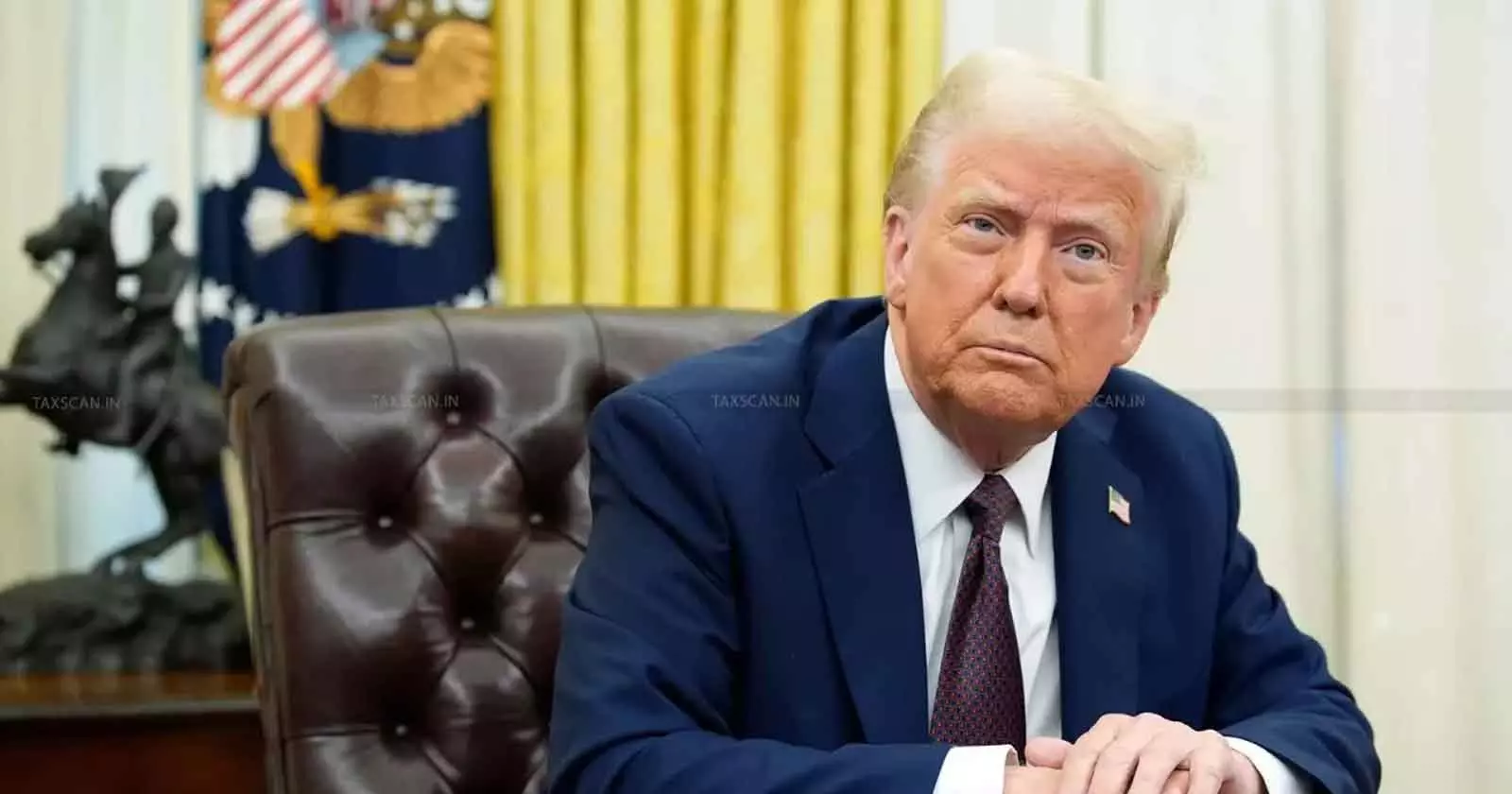Trump Imposes 25% Tariff on Indian Imports: What It Means for Trade, Exports, and Businesses
India has responded cautiously to Trump’s tariff move, prioritizing national interest, continuing trade talks, and adjusting oil imports to address U.S. concerns

On July 30, 2025, U.S. President Donald Trump announced a sweeping 25 percent tariff on all goods imported from India citing India’s high tariff structure and non-monetary trade barriers. He also pointed to India’s continued purchases of Russian oil and military equipment, calling them unacceptable during ongoing geopolitical tensions.
This happens after a previous threat in April 2025 to impose tariffs as high as 27 percent, which was paused pending trade negotiations. With talks stalling, Trump signed an executive order on July 31, making the tariffs effective from August 7, 2025.
This decision has triggered strong reactions in both countries, with experts warning of significant economic, business, and geopolitical consequences.
Trade Imbalance and the Tariff Trigger
In 2024, India exported $85.5 billion worth of goods to the U.S., while imports stood at $39.8 billion, resulting in a $45.7 billion trade surplus for India. The total bilateral trade was approximately $129.2 billion
Comprehensive Guide of Law and Procedure for Filing of Income Tax Appeals, Click Here
According to GTRI, when factoring in U.S. services exports (including education, arms, and tech), the U.S. actually enjoys an overall surplus of $35-40 billion. Still, the Trump administration has viewed India’s tariff regime as unfair and protectionist.
The tariff is part of a broader reciprocal trade policy Trump has championed, aimed at reducing trade deficits and protecting American manufacturing. His administration has also used trade policy to address strategic goals, such as discouraging ties with Russia and China.
Impact on India-US Trade
The tariff will affect an estimated 87 percent of India’s exports to the U.S., worth around $66 billion. Several key sectors will feel the brunt of the new duties:
- Pharmaceuticals ($8 billion in exports): Indian drugmakers like Sun Pharma and Dr. Reddy’s risk losing their price advantage. Generic drugs from India saved the U.S. $220 billion in healthcare costs in 2022. Higher costs could hit U.S. consumers and healthcare providers.
- Gems and Jewelry ($10 billion): India’s jewelry exports to the U.S. will face inflated costs, risking order delays and impacting thousands of artisans and small businesses.
- Textiles and Apparel: Though export value isn't specified, this labor-intensive sector supplies major American brands like Walmart and Gap. It now faces stiff competition from Vietnam and Bangladesh which enjoy lower or no tariffs.
- Electronics: India's role as a rising hub for iPhone assembly and electronic components may be compromised, especially as Apple and other U.S. firms consider alternate supply chain plans.
- Oil Trade with Russia: The penalty includes indirect action against India’s continued purchase of Russian oil. India currently buys 37% of its crude from Russia and the U.S. may apply further pressure to restrict these imports or penalize firms like Reliance Industries which has large oil trade agreements with Russia.
The tariff could affect nearly 10 percent of India’s total exports in just the July to September 2025 quarter, with long-term risks of supply chain shifts and permanent market losses.
Comprehensive Guide of Law and Procedure for Filing of Income Tax Appeals, Click Here
Business Implications
For Indian Businesses:
- Increased Costs: A 25 percent tariff reduces price competitiveness. Compared to Vietnam (20 percent tariff) and China (30 percent after negotiations), India risks losing crucial U.S. market share.
- Disrupted Supply Chains: Exporters may face canceled or delayed orders. For example, textile suppliers to U.S. retail giants may need to divert goods or renegotiate contracts.
- Job Losses: Sectors such as apparel and jewelry, which employ over 70 million workers, may experience layoffs if export volumes decline sharply.
- Stock Market Impact: On July 31, the Nifty 50 fell 0.35% and the Sensex dropped 0.36%. Export-driven sectors saw sharp declines. However, markets recovered slightly by the end of the day, reflecting hopes for continued negotiations.
For U.S. Businesses:
- Higher Consumer Prices: U.S. buyers may face higher prices for goods like generic drugs, textiles, and jewelry. This could add inflationary pressure, particularly in healthcare.
- Supply Chain Realignment: Importers may look to other countries like Vietnam or Mexico but sudden shifts may increase costs and disrupt operations.
- Boost for Domestic Industry: Some U.S. manufacturers could benefit from reduced competition, especially in electronics and metals. Analysts say benefits may be modest and short-term.
Broader Economic and Geopolitical Impacts
For India, reduced exports could slow GDP growth by up to 50 basis points. The rupee weakened after the announcement, reflecting investor anxiety. The Commerce Ministry has stated that it will protect Indian interests, especially small businesses and farmers, while continuing negotiations for a fair deal.
The geopolitical angle is also significant. India’s oil trade with Russia and military imports have long been sensitive issues for Washington. Trump’s tariff now links economic pressure with foreign policy objectives. U.S. lawmakers have already introduced bills proposing tariffs of up to 500 percent on countries, including India, that trade oil with Russia.
This could strain U.S.-India ties which have otherwise grown stronger as part of a strategic counter to China in the Indo-Pacific region.
India’s Strategic Response
Government’s Reaction
India has responded calmly and carefully to the U.S. tariff decision. The Ministry of Commerce and Industry said it is still "studying the implications" of Trump’s announcement. At the same time, India made it clear that it is still open to talks. Trade Minister Piyush Goyal said the government’s main focus is to protect farmers, small businesses, and entrepreneurs, especially those in the MSME (micro, small, and medium enterprises) sector.
The government also stated it will do everything needed to protect national interests, and pointed to the recent trade deal with the UK as an example of how India can open its markets while protecting sensitive sectors.
Market Reactions
Soon after Trump’s announcement, major Indian state-run oil companies, including Indian Oil Corporation, Hindustan Petroleum, and Bharat Petroleum, ceased buying crude oil from Russia. Instead, they turned to suppliers in the Middle East and West Africa, a move seen as a response to U.S. concerns about India’s ties with Russia.
Indian stock markets also reacted negatively. Shares of companies in sectors like textiles, automobiles, and pharmaceuticals dropped, as investors became worried about how the tariff would make Indian goods less competitive in the U.S. market.
Ongoing Talks and Next Steps
Even though the U.S. has announced the tariff, both countries are still in talks. A U.S. trade delegation is expected to visit India on August 25 for another round of discussions.
Some major issues still need to be resolved:
- Agricultural Access: The U.S. wants more access to India’s farm and dairy markets, but India sees this as a threat to its food security and millions of small farmers.
- Genetically Modified (GM) Products: The U.S. wants India to allow GM crops like corn and soya, but India is still unwilling to accept these demands due to safety and environmental concerns.
- Strategic Independence: India’s ties with Russia and BRICS are seen as going against U.S. foreign policy goals. This makes trade talks more complex, as the issues are not just economic but also geopolitical.
Support our journalism by subscribing to Taxscan premium. Follow us on Telegram for quick updates


